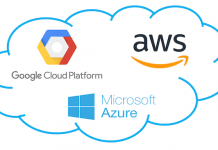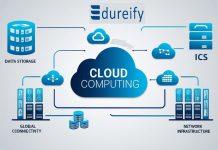Cloud computing is a general term for anything that involves delivering hosted services over the internet. These services are divided into three main categories or types of cloud computing: infrastructure as a service (IaaS), platform as a service (PaaS), and software as a service (SaaS).
A cloud can be private or public. A public cloud sells services to anyone on the internet. A private cloud is a proprietary network or a data center that supplies hosted services to a limited number of people, with certain access and permissions settings. Private or public, the goal of cloud computing is to provide easy, scalable access to computing resources and IT services.
Cloud infrastructure involves the hardware and software components required for the proper implementation of a cloud computing model. Cloud computing can also be thought of as utility computing or on-demand computing.
The name cloud computing was inspired by the cloud symbol that’s often used to represent the Internet in flowcharts and diagrams.
How does cloud computing work?
Cloud computing works by enabling client devices to access data and cloud applications over the internet from remote physical servers, databases, and computers.
An internet network connection links the front end, which includes the accessing client device, browser, network, and cloud software applications, with the back end, which consists of databases, servers, and computers. The back end functions as a repository, storing data that is accessed by the front end.
To know about Java script, click here.
Communications between the front and back ends are managed by a central server. The central server relies on protocols to facilitate the exchange of data. The central server uses both software and middleware to manage the connectivity between different client devices and cloud servers. Typically, there is a dedicated server for each application or workload.
Cloud computing relies heavily on virtualization and automation technologies. Virtualization enables the easy abstraction and provisioning of services and underlying cloud systems into logical entities that users can request and utilize. Automation and accompanying orchestration capabilities provide users with a high degree of self-service to provision resources, connect services and deploy workloads without direct intervention from the cloud provider’s IT, staff.
To know about the nodes, click here.
Types of cloud computing services
Cloud computing can be separated into three general service delivery categories or forms of cloud computing:
- a. IaaS providers, such as Amazon Web Services (AWS), supply a virtual server instance and storage, as well as application programming interfaces (APIs) that let users migrate workloads to a virtual machine (VM). Users have an allocated storage capacity and can start, stop, access, and configure the VM and storage as desired. IaaS providers offer small, medium, large, extra-large, and memory- or compute-optimized instances, in addition to enabling customization of instances, for various workload needs. The IaaS cloud model is closest to a remote data center for business users. Go to the official website of Edureify to know about some of the courses related to cloud computing.
- PaaS. In the PaaS model, cloud providers host development tools on their infrastructures. Users access these tools over the internet using APIs, web portals, or gateway software. PaaS is used for general software development, and many PaaS providers host the software after it’s developed. Common PaaS products include Salesforce’s Lightning Platform, AWS Elastic Beanstalk, and Google App Engine.
- SaaS. SaaS is a distribution model that delivers software applications over the internet; these applications are often called web services. Users can access SaaS applications and services from any location using a computer or mobile device that has internet access. In the SaaS model, users gain access to application software and databases. One common example of a SaaS application is Microsoft 365 for productivity and email services.
Cloud computing deployment models
Private cloud services are delivered from a business’s data center to internal users. With a private cloud, an organization builds and maintains its underlying cloud infrastructure. This model offers the versatility and convenience of the cloud while preserving the management, control, and security common to local data centers. Internal users might or might not be billed for services through IT chargeback. Common private cloud technologies and vendors include VMware and OpenStack.
In the public cloud model, a third-party cloud service provider (CSP) delivers the cloud service over the internet. Public cloud services are sold on demand, typically by the minute or hour, though long-term commitments are available for many services. Customers only pay for the central processing unit cycles, storage or bandwidth they consume. Leading public CSPs include AWS, Microsoft Azure, IBM, and Google Cloud Platform (GCP), as well as IBM, Oracle, and Tencent. Download the Edureify app now to gain more knowledge on this.
What is a Hybrid Cloud?
A hybrid cloud is a combination of public cloud services and an on-premises private cloud, with orchestration and automation between the two. Companies can run mission-critical workloads or sensitive applications on the private cloud and use the public cloud to handle workload bursts or spikes in demand. The goal of a hybrid cloud is to create a unified, automated, scalable environment that takes advantage of all that a public cloud infrastructure can provide, while still maintaining control over mission-critical data.
Frequently Asked Questions (FAQs)
Question:- What is cloud computing?
Answer:- Simply put, cloud computing is the delivery of computing services—including servers, storage, databases, networking, software, analytics, and intelligence—over the Internet (“the cloud”) to offer faster innovation, flexible resources, and economies of scale.
Question:- What are the 3 types of cloud computing?
Answer:- There are also 3 main types of cloud computing services: Infrastructure-as-a-Service (IaaS), Platforms-as-a-Service (PaaS), and Software-as-a-Service (SaaS).
Question:- What is cloud computing for example?
Answer:- Cloud allows network-based access to communication tools like emails and calendars. WhatsApp is also a cloud-based infrastructure when it comes to communication. It is also one example of cloud computing. All the messages and information are stored in service providers’ hardware.
Question:- Is Google Drive a cloud?
Answer:- Google Drive is a free cloud-based storage service that enables users to store and access files online. The service syncs stored documents, photos, and more across all of the user’s devices, including mobile devices, tablets, and PCs.
Question:- Where is cloud computing used?
Answer:- Uses of the cloud include data storage, offering remote access to any work-related data. The role of cloud computing on a corporate level can be either for in-house operation or as a deployment tool for software or services the company develops for the public.
Master Your Coding Skills with BootSelf AI
If you're looking to enhance your coding abilities and upskill in artificial intelligence, look no further than the BootSelf AI app. This innovative platform provides AI-based coding lessons that are tailored to your individual learning pace.
Available on both iOS and Android, you can download the BootSelf AI app and start mastering coding skills today:









